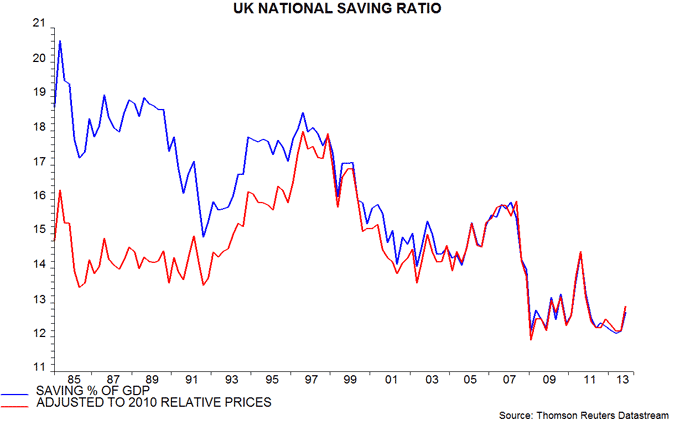Entries from April 1, 2014 - April 30, 2014
Global growth rebound on track despite weak Japan
Recent news is consistent with the forecast here that global economic momentum will reach a short-term low in May and rebound over the summer.
Six-month growth in global* industrial output is estimated to have stabilised in March after falls in January and February, based on data covering two-thirds of the aggregate – see chart. A further decline is likely in April / May, partly reflecting lower production in Japan following the recent sales tax rise. Japanese manufacturers expect to cut output by 1.3% between March and May, with a larger reduction suggested by a plunge in purchasing managers’ new orders.
The forecast of global economic reacceleration from May rests on a pick-up in real narrow money expansion since late 2013 and a more recent confirming rise in the longer leading indicator monitored here. A definitive March reading of the leading indicator will be available on 13 May but preliminary data suggest another monthly gain – an estimate is included in the chart. The recent low in the indicator, meanwhile, may be revised from January to December. This would be consistent with a May trough in industrial output growth, allowing for the typical 4-5 month lead.
Global real money expansion stabilised at a solid level in March, implying favourable economic prospects through September, at least. The recent pick-up has been driven by the US; Japanese real money, by contrast, will be squeezed temporarily by the inflation boost from the sales tax rise – second chart**. The Japan effect could lower the global aggregate from April.
The prospect of a summer economic rebound may warrant a more cyclical bias in equity portfolios: stocks in cyclical industries tend to outperform non-cyclicals when the leading indicator rises significantly – third chart.
*G7 developed and E7 emerging economies.
**Includes April forecasts for US and Japan.
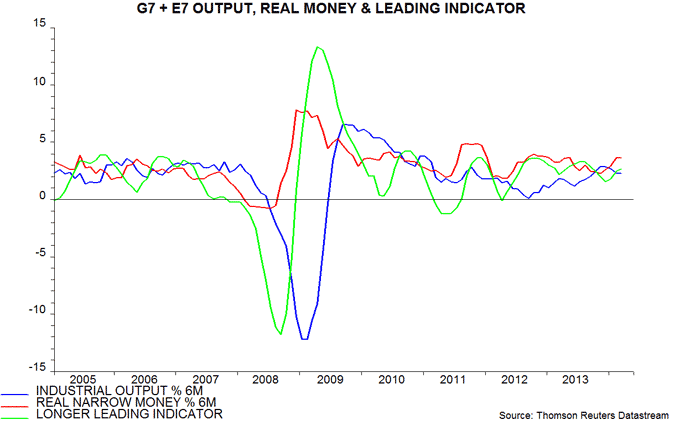
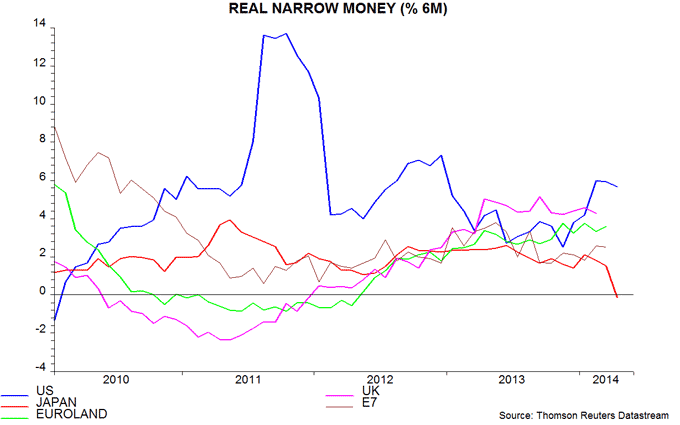
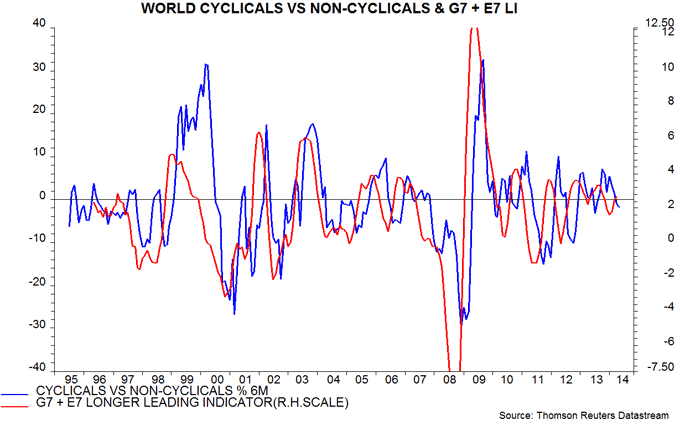
Eurozone narrow money trends still positive
The “monetarist” rule is that money supply changes lead activity by about six months and inflation by about two years. The forecasting approach here emphasises narrow money – currency plus sight deposits – when applying the rule. This approach was the basis for forecasts that the Eurozone economy would recover from late 2012 and inflation would bottom around end-2013, reviving in 2014-15.
The first forecast has proved correct and current monetary trends point to the economic upswing continuing through late 2014, at least. The “flash” April purchasing managers’ output index released last week was the highest since May 2011 and consistent with quarterly GDP growth of about 0.5% (not annualised). Six-month real narrow money* expansion remains robust, according to March statistics released today – see first chart.
The jury has yet to return a verdict on the inflation forecast. The annual increase in core consumer prices – excluding energy, food, alcohol and tobacco – fell to 0.7% in December 2013 and revisited this level in March, partly reflecting a drag from Easter timing effects. The expectation here remains for a gradual recovery in price pressures through 2014.
Real money** growth was much weaker in peripheral economies than in the core grouping over 2010-12 but this gap closed in late 2013 and recent trends remain similar – second chart. The message is that economic recovery is now broadly-based across countries, increasing confidence in its sustainability.
The final chart shows real money growth in the big four economies. The range is unusually narrow, signalling similar economic prospects. The most notable recent change is a pick-up in France, suggesting that economic news will surprise positively later in 2014.
Broad money and credit trends remain weak but neither predicted the extent of the recent economic recovery. The demand to hold broad money has been depressed by falling deposit interest rates*** while bank lending is loosely correlated with the economic cycle, with a tendency to lag.
*Real non-financial M1, i.e. currency and overnight deposits of households and non-financial firms deflated by consumer prices.
**Real non-financial M1 is not available by country; the second and third charts refer to real overnight deposits and include holdings of non-bank financial firms.
***Equivalently, the velocity of circulation of broad money has risen.



UK MPC preview: "MPC-ometer" suggesting hawkish shift
The uneasy truce on the MPC may break down in May, with one or more members expressing support for an early interest rate rise, according to the “MPC-ometer” model followed here.
The MPC-ometer is designed to forecast the “average interest rate vote” of Committee members based on a small number of economic and financial inputs relevant for assessing the outlook for growth and inflation*. Estimated in 2006, the model proved useful for predicting interest rate changes in the late 2000s; it also signalled the expansions of QE in 2011 and 2012**.
The preliminary model reading for May is +5 basis points, formally consistent with two votes for a quarter-point rate hike and seven for no change. The preliminary reading assumes that April PMI and consumer survey results are equal to February / March averages, while the “flash” first-quarter GDP report released on 29 April shows quarterly growth of 1.0%.
With the unemployment rate below 7.0%, MPC members are no longer shackled by the original forward guidance framework. The MPC-ometer reading was negative, signalling an easing bias, when the framework was introduced in August. It turned significantly positive in late 2013 but fell back through April, partly reflecting lower inflation expectations. The May reading, if confirmed, would be the highest since January.
Forward guidance may actually have harmed transparency by limiting MPC members’ ability to communicate how their views have shifted in response to much stronger-than-expected GDP and labour market performance. The May meeting is the hawks’ chance to escape the dove cote. Governor Carney faces a challenge in controlling dissent and convincing markets that forward guidance mark 2 will prove any more durable than its ill-judged predecessor.
*The inputs include GDP growth, business and consumer survey responses about future activity and prices, average earnings growth, changes in share prices and the exchange rate, and credit spreads.
**The model was modified in 2009 to incorporate QE, with the relevant parameter implying that £75 billion of gilt-buying is the policy equivalent of a quarter-point rate cut.
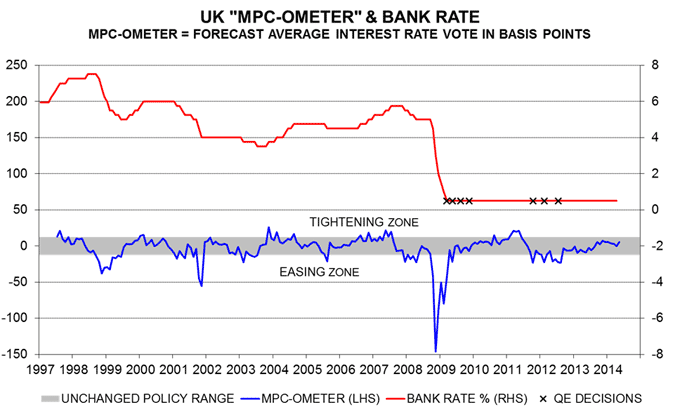
UK vacancies / short-term unemployed signalling stronger wages
Last week’s UK employment report casts further doubt on the Bank of England’s claim that there is still significant disinflationary slack in the labour market.
First, the vacancy rate, i.e. the stock of unfilled openings expressed as a percentage of the number of employee jobs, rose to a six-year high of 2.2% in the three months to March and is above its 2.0% average since 1995*. If the supply of labour were unusually high relative to demand, employers would fill openings rapidly and the vacancy rate would remain low.
Secondly, the short-term unemployment rate, i.e. the number unemployed for six months or less expressed as a percentage of the labour force, fell to a six-year low of 3.3% over December-February and is below its 3.5% average since 1995 – see first chart. This suggests that job losers and people entering the labour force are finding work relatively swiftly – consistent with the message of strong demand from the vacancy rate. The current 3.3% rate is close to the 3.2% level reached before the start of the last interest rate upswing in November 2003.
The still-elevated overall unemployment rate – 6.9% versus a post-1995 average of 6.4% – reflects a higher-than-normal proportion out of work for more than 12 months. Some of these people may lack skills or motivation, or be discriminated against by employers, resulting in them having less influence on wage-setting.
The longer-term unemployed, and part-timers wanting additional hours, represent “slack” in the widest sense but the issue for the Bank is whether this would be taken up only in a boom scenario involving unacceptable wage and price pressures.
The suggestion that the vacancy and short-term unemployment rates are more important for pay trends and the inflation outlook is supported by correlation analysis and US research. The post-1995 correlation coefficients of average earnings growth with 1) the vacancy rate, 2) the short-term unemployment rate and 3) the over-12-month unemployment rate are 0.60, 0.72 and 0.43 respectively**.
In the US, Robert Gordon of Northwestern University has demonstrated that an inflation model using the short-term rather than total unemployment rate has produced superior forecasts in recent years – the total rate model predicted, incorrectly, that inflation*** would fall below 0.5% in 2012-13. The current US short-term unemployment rate, like its UK counterpart, is beneath its post-1995 average – second chart. The US vacancy rate, meanwhile, is also at a six-year high.
The Fed and Bank of England are “exploring” whether remaining labour market slack is disinflationary by waiting for a pick-up in wage pressures before adjusting policy. Labour costs, however, generally move with prices rather than before, so this strategy implies a high risk of acting too late to prevent an inflation overshoot.
*The vacancy rate was estimated before April 2001 by linking the current employer-survey-based vacancies series with an earlier series covering vacancies at job centres.
**Positive correlation with vacancy rate, negative with unemployment rates.
***Quarterly change in personal consumption deflator, annualised.
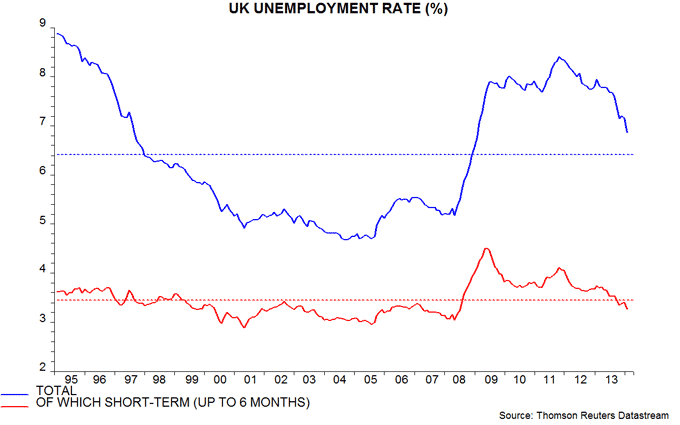

UK economics-based election predictor suggests hung parliament
An analysis of economic influences on political popularity suggests that the Conservatives will move ahead of Labour in the polls by the time of the May 2015 general election but their lead will be insufficient to deliver a majority in the House of Commons, and may not even result in the party holding the most seats in a hung parliament.
Statistical analysis of Guardian-ICM poll results since 1984 shows that the voting intentions differential between the main governing and opposition parties depends positively on average earnings growth and house price inflation, and negatively on the unemployment rate, retail price inflation and interest rates (Bank rate). The table reports the estimated sensitivities of the differential (i.e. Conservatives minus Labour currently) to these factors. A rise in headline average earnings growth, for example, from the current 1.7% to 2.7% would boost the Conservatives relative to Labour by 4 percentage points. An increase in Bank rate from 0.5% to 1.5% would have the opposite effect.
| Impact on Conservative-Labour differential of 1 percentage point rise in: | |
| Average earnings growth | +4 |
| Unemployment rate | -1 |
| Retail price inflation | -2 |
| House price inflation | +0.5 |
| Bank rate | -4 |
The model from which these sensitivities are derived also allows for “honeymoon” effects enjoyed by newly-elected governments – larger when the election results in a change of control – and a similar goodwill boost when there is a mid-term change of prime minister (Thatcher/Major in 1990 and Blair/Brown in 2007). The chart below shows the history of the poll differential between the main governing and opposition parties and the “prediction” of the model. While there are periodic significant divergences, it is, perhaps, surprising how much of the variation in polls can be explained by economic factors and honeymoon effects.

The Guardian-ICM poll published this week reports a Conservative-Labour differential of -5 percentage points, which is in line with the current model estimate. Election “swingometers” designed to translate voting intentions into seat predictions indicate that this would deliver a sizeable Labour majority. The next chart, derived from the swingometer on the Electoral Calculus website, shows required Conservative-Labour differentials that would result in majorities for either party for different levels of support for the Liberal Democrats, assuming that UKIP and smaller parties account for 10% and 5% of the vote respectively*. If the Lib Dems maintain their 12% showing in the latest Guardian-ICM poll, the suggestion is that the Conservatives need to open up a lead of about 6 percentage points over Labour to achieve a majority, and to be 3 points ahead to hold the most seats in a hung parliament, implying a first shot at forming a new coalition government.

Economic trends are moving in the Conservatives’ favour but will they deliver the necessary turnaround in the polls? The model can be used to examine this issue. The first scenario considered assumes that the economy performs in line with the Bank of England’s latest forecast**. The Bank expects average earnings growth to rise to 2.75% by the fourth quarter of 2014 and 3.75% by end-2015. The unemployment rate drops from the current 6.9% to 6.5% by the time of the election, while inflation is broadly stable. The forecast incorporates the market expectation that overnight interest rates will rise to 0.8% in the second quarter of 2015, implying a quarter-point increase in Bank rate. The Bank does not publish its projection for house prices – these are assumed to rise by 10% per annum. On these assumptions, the model estimates that the Conservatives would move into a 1.5 percentage point lead by May 2015, i.e. insufficient even for them to gain a plurality of seats in a hung parliament – see chart below.
The judgement here is that the economy will perform more strongly than the Bank expects, leading to a more rapid fall in unemployment and greater upward pressure on earnings. The second scenario considered assumes that earnings growth rises to 4% by the time of the election, while the unemployment rate drops to 5.7%. An additional difference is that Bank rate is held at 0.5% until after the election. The other assumptions – i.e. for inflation and house prices – are unchanged. According to the model, this “best case” scenario for the Conservatives would give them a lead of about 6 percentage points over Labour by May 2015, suggesting that they could scrape home with a single-figure seat majority if Lib Dem and UKIP support remains at current levels.
The problem, of course, is that the scenario is internally inconsistent – the strong pick-up in wage growth would be likely to push inflation higher and force the Bank of England to raise interest rates. A final scenario was considered maintaining the “best case” assumptions for earnings and unemployment but in which retail price inflation rises from the current 2.5% to 3%, while Bank rate is increased in two quarter-point steps to 1.0% by May 2015, with this leading to a slowdown in house prices. The Conservative-Labour lead is reduced to 2.5 percentage points, suggesting that the two parties would hold similar numbers of seats in a hung parliament.

Summing up, the modest impact of better economic news on Conservative support is understandable, because strong growth has only recently started to feed through to a recovery in real earnings. Faster pay expansion and a further unemployment decline could lift the Conservative-Labour differential by as much as 10 percentage points over the next 12 months. The associated economic scenario, however, would warrant a rise in interest rates, which would probably reverse part of the Tory gain. The outcome of the 2015 election will depend importantly on whether the Bank of England sets policy purely on economic grounds or delays necessary action to avoid overt influence on a close political race.
*Increasing the UKIP percentage to 15% has only a minor effect on the results.
**February Inflation Report forecast based on market-implied interest rates.
Is UK national saving too low?
The Office for National Statistics recently announced that its implementation of a new accounting framework in September 2014 will substantially boost the household saving ratio. Specifically, the increasing pension entitlements of members of funded defined benefit schemes will, from September, be included in income and saving. Initial work indicates that the change will boost annual saving ratios over 1997-2011 by between 3.4 and 6.3 percentage points. The saving ratio of 5.0% in the fourth quarter of 2013 could rise to about 10%.
The Financial Times article that covered this story was titled “Data shake-up turns UK into nation of savers”. The pension accounting change, in fact, will have no impact on the national saving ratio. The rise in the household ratio will be counterbalanced by a fall in recorded saving of companies and government bodies responsible for funded defined benefit schemes. The change, indeed, should turn the current corporate financial surplus – the excess of retained income over capital spending – into a deficit.
Total national saving out of domestic income was equal to 12.7% of GDP in the fourth quarter. This ratio has trended sideways since the 2008-09 recession but is far below its average of 16.0% since 1985 – see chart.
Is this a concern? Saving is necessary to fund capital accumulation to support supply-side growth. The relative price of capital goods, however, has been trending lower in recent decades, partly reflecting the IT revolution. A given national saving ratio, therefore, funds a higher real investment share of GDP than in the past. The chart shows an alternative measure that adjusts for this relative price effect*. This real saving ratio is much closer to its long-run average.
The value of saving, moreover, depends on the quality of the investment it finances. The real saving ratio rose above average over 2006-07 but much of the associated capital accumulation was misdirected, as evidenced by a subsequent prolonged slump in productivity. If capital allocation has improved, the current low ratio may not act as a constraint on long-run economic growth.
A rise in aggregate saving would be welcome and may occur if fiscal consolidation continues and the Bank of England normalises interest rates. The current saving ratio is of less concern for longer-run economic prospects than the risk that the Bank will hold rates below a rising “neutral” level, as it did during the mid 2000s, resulting in further capital misallocation.
*The alternative measure shows the hypothetical saving ratio that would have had the same purchasing power in terms of capital goods assuming prices fixed at their 2010 level.